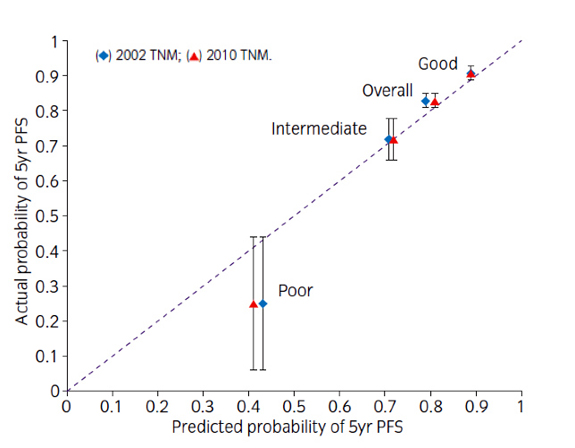BERKELEY, CA (UroToday.com) - The survival of patients with renal cell carcinoma (RCC) is closely related to initial TNM stage, with 5-year survival rates of up to 90% in localized disease, and as low as 13% for metastatic disease.[1] With such a diverse prognosis, predicting the risk of disease recurrence and survival for RCC allows patient counselling and selection of follow-up regimens.[2]
The Kattan nomogram is one of the most widely used and externally validated prognostic systems and it includes clinical (symptom at diagnosis) and pathological (size, TNM stage, histology) parameters to predict the probability of RCC recurrence post nephrectomy.[3] The TNM staging for RCC was updated in 2010 with tumours with renal vein involvement or perinephric fat involvement being re-classified as pT3a, whereas those with adrenal involvement was reclassified as pT4 cancers.[4]Since the Kattan nomogram includes a different weighting score for pT3a and pT3b disease, the survival predictions are affected by the TNM change.
In this article, we examined the effect of the 2010 TNM reclassification on the validity of the Kattan nomogram predictions in a cohort of patients undergoing nephrectomy for RCC at a tertiary centre in the United Kingdom in the period 2004-2008. In this 5-year study period we identified 291 patients (mean age 61.6 years) out of whom 87% had clear cell RCC on histology.
Using the Kattan nomogram, each patient had their probability of 5-year recurrence-free survival calculated using the 2002 TNM classification and was grouped into three prognostic groups – 'good' (probability of 5-year recurrence free survival >80%), 'intermediate' (60-80%), and 'poor' (<60%) – for analysis. Tumour stage was then re-assigned according to the 2010 TNM classification and this led to an increase in the number of patients with pT3a (from 30 to 75), a reduction in the number of pT3b (from 57 to 10) and a small increase in pT4 cases (1 to 3). This altered the proportion of patients in the Kattan prognostic group of ‘good’ (from 61% to 69%), ‘intermediate’ (from 29% to 22%) and ‘poor’ (from 10% to 8%).
Using the 2002 and 2010 TNM classification, the estimated 5-year progression-free survival for the whole cohort was 79.8% and 81.8%. The actual observed 5-year progression-free survival was 83% (Figure 1). Furthermore, there was no statistical difference in the 5-year progression-free survival between predicted (2010 TNM) and observed in the ‘good’ (89.5% vs 91.6%) and ‘intermediate’ groups (72.1% vs 72.1%). In the ‘poor’ prognostic group, the Kattan nomogram predicted a higher survival (43.2% for 2002 TNM and 41.5% for 2010 TNM) compared with the actual outcomes observed (25.6%); however, this was not statistically significant and the analyses included small numbers in the ‘poor’ group (n = 28).
We have therefore shown that in our cohort, the Kattan nomogram performed well in predicting progression-free survival outcomes in RCC with the 2010 TNM reclassification.

Figure 1: Comparison between actual and predicted probability of 5-year progression-free survival (dotted line represents perfect prediction)
References:
- Motzer, R.J., et al., Effect of cytokine therapy on survival for patients with advanced renal cell carcinoma. J Clin Oncol, 2000. 18(9): p. 1928-35.
- Volpe, A. and J.J. Patard, Prognostic factors in renal cell carcinoma. World J Urol, 2010. 28(3): p. 319-27.
- Kattan, M.W., et al., A postoperative prognostic nomogram for renal cell carcinoma. J Urol, 2001. 166(1): p. 63-7.
- Edge, S.B. and American Joint Committee on Cancer., AJCC Cancer Staging Manual. 7th ed. 2010, New York: Springer. xiv, 648 p.
Written by:
Rajan Veeratterapillay, SpR (Urol)a and Rakesh Heer, PhD, F.R.C.S. (Urol),a, b part of Beyond the Abstract on UroToday.com. This initiative offers a method of publishing for the professional urology community. Authors are given an opportunity to expand on the circumstances, limitations etc... of their research by referencing the published abstract.
a) Department of Urology, Freeman Hospital
b) Northern Institute for Cancer Research, Newcastle University, Newcastle Upon Tyne, UK

More Information about Beyond the Abstract


